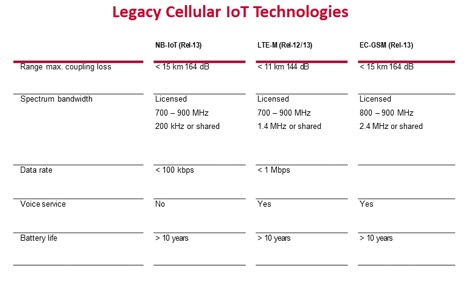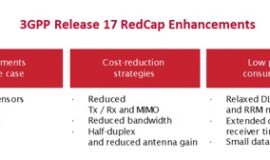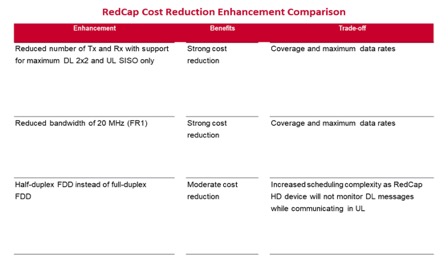
RedCap: A new cellular IoT technology for the 5G era
By Dylan McGrath, 5G industry solutions, Keysight Technologies
Electronics Test & Measurement Wireless Engineering IoT 5G cellular Editor Pick IoT Keysight ReCap test wirelessOver the years, the cellular industry has introduced several wireless technologies designed to connect Internet of Things (IoT) devices to the Internet. These cellular IoT technologies, listed in Table 1, have included LTE Cat M, extended coverage GSM IoT (EC-GSM-IoT), and narrowband IoT (NB-IoT). All were designed to minimize the added cost of cellular connectivity to maximize the cost-benefit of remote wireless access.
The latest and most powerful cellular IoT technologies to emerge is the first such technology capable of leveraging the power of 5G. The Third Generation Partnership Project (3GPP)’s Release 17 contains enhancements that enable reduced capability, or RedCap, devices to operate on 5G networks.

Source: Keysight Technologies
As the name implies, 5G RedCap devices connect to the Internet via 5G, but don’t have the full capabilities (and performance) of conventional devices like smartphones and other more advanced user equipment (UE) operating on 5G networks. While RedCap devices such as wearables, sensors, surveillance devices, and other IoT equipment do not have the full throughput, bandwidth, and latency capabilities of the 5G specification, they typically have much more stringent power consumption and cost limitations. RedCap devices benefit from the scale of 5G deployments, but leverage fewer 5G capabilities for an optimum balance of features versus cost and power consumption.

Source: Keysight Technologies
3GPP specifies three use cases for RedCap devices: industrial sensors, surveillance devices, and wearables. 3GPP’s technical report (TR) 38.875 specifies the maximum data rate, end-to-end (E2E) latency, and service availability for each use case, as shown in Table 2.
RedCap cost/performance tradeoffs
To reduce complexity, cost, and power consumption, RedCap devices use fewer antennas than standard 5G devices. This not only reduces cost, but also reduces the maximum number of multiple-input multiple-output (MIMO) layers. RedCap devices only support 2×2 MIMO for the downlink and single-input single-output for the uplink.
RedCap also limits device bandwidth capability compared to standard 5G UEs in order to limit power amplifier (PA) costs. RedCap devices use only bandwidths of 20 MHz for frequency range 1 (FR1) and 100 MHz for frequency range 2 (FR2).

Source: Keysight Technologies
Another cost-saving enhancement introduced in 3GPP Release 17 for RedCap devices is support for half-duplex frequency division duplex (FDD) transmission. While half-duplex FDD significantly reduces cost by enabling RedCap devices to use switches rather than the duplexers required for full-duplex FDD, it does have some drawbacks. A RedCap device cannot perform both transmission and reception simultaneously. That’s because a device using half-duplex FDD:
- Will not detect scheduling information for downlink and uplink in the same set of symbols
- Cannot monitor downlink messages while configured in uplink mode
- Cannot send uplink control information while monitoring downlink
In case of conflict, RedCap devices can decide what to do based on their particular implementation.
RedCap power saving enhancements
RedCap also implements several simplifications of the 5G specifications specially to increase power efficiency, minimize the power consumption, and extend the battery life of RedCap devices. For example, RedCap employs a reduced network monitoring scheme compared to the full 5G specification. RedCap devices limit the number of blind decoding and control elements monitored in the physical downlink control channel (PDCCH), reducing the amount of power required for these tasks.
Another power-saving simplification implemented by RedCap is extended discontinuous reception (eDRX). RedCap increases eDRX cycles when the device disconnects from the network or becomes idle, substantially prolonging the battery life of a RedCap device. Longer eDRX cycles are particularly valuable in specific use cases such as stationary wireless sensors, because increasing the eDRX cycles comes with the tradeoff of decreasing the mobility performance of the device. (Imagine a wireless sensor monitoring a railroad track that needs to only connect to the network periodically to transmit data.)
RedCap also relaxes radio resource management (RRM) requirements for devices that are not located at the cell edge and introduces a radio resource control (RRC) inactive state, which allows the UE to make small data transmissions without transitioning the RRC-connected state. Both enhancements are designed to save power and extend the battery life of RedCap devices.
RedCap device complexity reductions
The final aspect of RedCap enhancements are simplifications put in place to reduce the complexity of RedCap devices. These enhancements can also reduce power consumption and device cost, but their primary purpose is to reduce the complexity of devices so that the RF components can fit in devices with very small or unconventional form factors (imagine, for example, wearable devices such as smart glasses).
RedCap simplifications to reduce device complexity include support for only a single carrier (with no support for carrier aggregation), and support for single connectivity, enabling the RedCap device to operate in 5G standalone mode only. RedCap also supports 5G power class 3, which limits the effective isotropic radiated power (EIRP) of devices to reduce the size of the device’s battery.
Implications for the 5G network
The Release 17 enhancements outlined above are focused mainly on the RedCap devices. But RedCap enhancements have implications for the 5G networks, too.
The biggest impact of RedCap on 5G networks is that the networks must adapt to the specific features of RedCap during the random-access process and when the device stays connected. New information elements (IEs) introduced for RedCap enable the bandwidth to adapt dynamically based on the actions taken by the device. For example, some of these new IEs pertain to the permission for a RedCap UE to camp in a cell or do so using half-duplex mode. (Some IEs are required to enable a RedCap device to connect to a cell; when these IEs are not detected the cell will bar RedCap devices from connecting and the RedCap device will have to start the RRC procedure to connect to another cell where the required IEs are present).
Another of the new IEs enables the application of RedCap relaxations for stationary devices and devices at the cell edge.
Some of the new IEs pertain to bandwidth part (BWP) configuration, which allows flexible spectrum use to achieve power savings by dynamically adapting the assigned bandwidth depending on what the UE is doing. Low bandwidths impact the random-access channel (RACH) procedure used by the devices to access the network. The network can specify a BWP for RedCap devices or reduce the size of the BWP for these devices to attach to the network. However, this enhancement has limited value for RedCap because, as discussed above, RedCap devices operate at a reduced maximum bandwidth of 20 MHz.
The new signaling parameters and procedures introduced in Release 17 to enable the network to support RedCap devices require device engineers to check the compatibility of their devices to ensure connectivity. 5G device development engineers also need tools to check RedCap parameters for debugging purposes.
RedCap market outlook
The outlook for the adoption of 5G RedCap devices in the coming years is bright. Analysts expect the first 5G RedCap chipsets to begin appearing this year and in 2024, with the first commercial RedCap devices to enter the market in 2025 and 2026. After 2026, the growth of commercial RedCap devices is expected to rise steeply as industries and consumers rush to adopt 5G-connected wearables for health monitoring and other applications, low-cost wireless sensors for industrial data collection and asset-tracking, and surveillance devices for use in smart cities, factories, and other applications.
Like all cellular devices, comprehensive test methodologies and equipment are critical to bringing 5G RedCap devices to market. The right testing approach is critical to validate the protocol compliance and performance of 5G RedCap devices.
————————————

Dylan McGrath is the industry solutions manager for 5G at Keysight Technologies Inc., global manufacturer and supplier of electronics test and measurement equipment and software. Source: Keysight
Dylan McGrath is the industry solutions manager for 5G at Keysight Technologies Inc., global manufacturer and supplier of electronics test and measurement equipment and software.
https://www.keysight.com/ca/en/home.html
